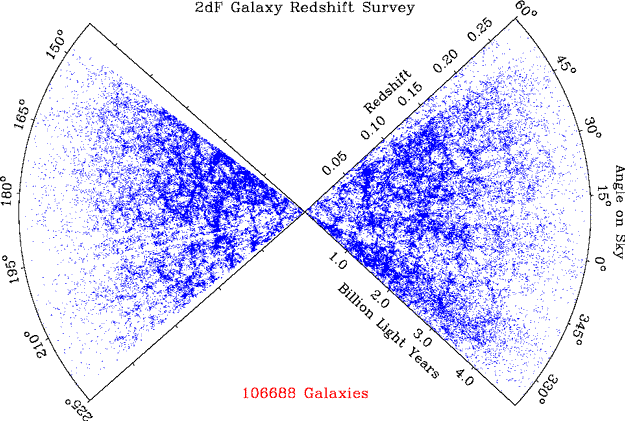
|
Explanation: What can 100,000 galaxies tell you? Perhaps the structure and composition of the universe. Astronomers using the Two Degree Field (2dF) spectrograph on the Anglo-Australian Telescope (AAT) in Australia have now measured the redshifts of over 100,000 galaxies in a thin ribbon of the sky. The results show how galaxies are scattered in the universe out to 4 billion light years. Huge clusters, long filaments, and empty voids measuring over 100 million light years across are visible in the resulting 2dF map, pictured above. The map is interesting not only for what it shows but also for what it does not show. It does not show even larger structures that would be expected were the universe filled to critical density with normal matter. These results do not contradict recent evidence that most of the universe is made of some type of unusual dark energy, however.
|
January February March April May June July August September October November December |
| ||||||||||||||||||||||||||||||||||||||||||||||||
NASA Web Site Statements, Warnings, and Disclaimers
NASA Official: Jay Norris. Specific rights apply.
A service of: LHEA at NASA / GSFC
& Michigan Tech. U.
Based on Astronomy Picture
Of the Day
Publications with keywords: cosmology - universe - 2dF survey
Publications with words: cosmology - universe - 2dF survey
See also:
- APOD: 2025 November 23 Á The Observable Universe
- APOD: 2024 December 1 Á Cosmic Latte: The Average Color of the Universe
- APOD: 2024 October 20 Á Dark Matter in a Simulated Universe
- APOD: 2024 July 1 Á Time Spiral
- APOD: 2023 December 31 Á Illustris: A Simulation of the Universe
- APOD: 2023 July 5 Á A Map of the Observable Universe
- APOD: 2023 June 29 Á A Message from the Gravitational Universe
